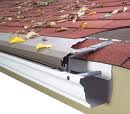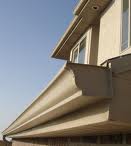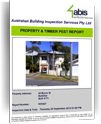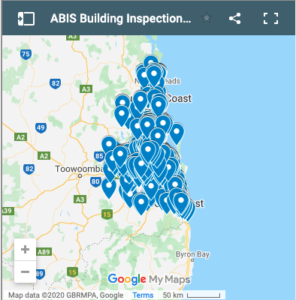A Gutter is a narrow channel, or trough designed to collect and transfer rainwater to a suitable drain. Gutters collect and diverts rainwater to protect a building’s fabric and foundation by channeling water away from a building’s base. It also helps to reduce erosion, prevents leaks in subfloor spaces, protects painted surfaces by reducing exposure to water, and provides a means to collect rainwater for later use. Typically, it is a discrete trough of metal, or other material that is suspended beyond the roof edge and below the projected slope of the roof.
Rain gutters can be constructed from a variety of materials, including zinc, galvanised steel, painted steel, painted aluminium, plastic, and concrete.
Gutters must be installed with a “fall” so that water flows towards the down-pipe or drain connection. Gutters with inadequate fall will allow water to pond shortening the life of the gutter and creating a condition conducive to timber building and pest inspections activity.
Different styles of gutter, known as profiles, are produced. A box gutter is a deep gutter which is concealed within the structure of the roof. Cold forming technology exists to allow continuous gutters to be created, on site, in long individual lengths suitable to roof edge conditions, thereby reducing joints along the length of the gutter. These mostly joint free gutters are referred to as “seamless”, and available in various shapes, sizes, and finishes
Clogged gutters can cause water leakage into the house as the water backs up as well as encourage mosquitoes to breed.
Guttering should be installed by a licensed roof plumber. Having the correct roof plumbing will ensure that water will flow off the roof correctly in even the heaviest of rainfall, or if there is a water tank, that water catchment is maximised. The roof plumber will take the size, pitch and material of the roof into account when designing the appropriate water catchment or stormwater drainage system and also when selecting the guttering material as certain materials may be incompatible with each other and the roof covering.
According to BCA Vol 1 Part 3.5.2
“The roof drainage system including gutters and downpipes should be connected to a compliant stormwater drainage system and should be designed so that any overflow during heavy rain periods is prevented from flowing back into the building
Gutters, downpipes and flashings must:
• Be manufactured in accordance with AS/NZS 2179.1 for metal
• Be manufactured in accordance with AS 1273 for UPVC components and
• Be compatible with all roofing materials in accordance with BCA Vol 1 3.5.1.3
• Not contain any lead if used as part of a water catchment system.
Mandatory guttering size will vary depending upon the average rainfall intensity and roof catchment area.
Gutters must be installed with a fall of not less than 1:500 for eaves gutters, unless fixed to metal fascias and 1:100 for box gutters.
Eaves gutters must be supported by brackets securely fixed at stop ends and at no more than 1.2m centres.
Valley gutters on a roof with a pitch more than 12.5 degrees must have width of not less than 400mm and be wide enough to allow roof covering to overhang not less than 150mm each side of the gutter or if the roof has a pitch more than 12.5 degrees be designed as a box gutter.
Where high-fronted gutters are installed, provision, provision must be made to avoid any overflow back into the roof by installing slotted gutters or the like.
Downpipes must not serve more than 12m of gutter length for each downpipe and be located as close to possible to valley gutters and if more, provision for overflow must be made to the gutter Downpipes must be selected in accordance with the appropriate eaves gutter section.
Stormwater drainage systems are not designed to remove all of the water during exceptionally heavy rain. Accordingly, it is necessary to design and install the system so that when overflowing occurs any water is directed away in a manner which ensures that it does not pond against or enter the building. This may be achieved by using slotted gutters, oversized gutters and downpipes, locating the gutter so that it is below the top edge of the fascia or the installation of rainwater heads with overflow slots”.
Different Types of Gutters:
Half round gutters
As there are no square corners, half round gutters do not collect as much debris as other gutter types. They also empty quicker due to a larger water-carrying capacity.
Quad gutters
Square fronted gutters
These are designed to hide the ends of roof sheets and have slots in them to help the water overflow freely in heavy rain without entering the roof space.
Smoothline gutters
These are similar to half round gutters but they have a flat back and are fixed using internal brackets.
Gutter & Downpipe Problems:
Rusted or poorly installed gutters are common problems where easily recognisable signs of deterioration are paint bubbling or rust on the underside of the gutters and stains on the underside of eaves. If the problem is minor, small holes in gutters may be patched. However, indications of more disastrous guttering faults are stains around windows, sometimes down the walls and in the case of skillion roofs, even on the ceilings.
Such leaks are most likely to be caused by gutter overflow due to a number of reasons. They may be clogged with debris, or the slope towards the downpipe may be insufficient. Blocked downpipes and drains may also lead to water overflowing gutters. Or a guttering overflow may occur during a downpour because the large volume of water can’t be drained away fast enough. An “overloaded” roof drainage system will need more downpipes installed.
Overflow faults are worsened when the outside edge of the spouting is higher than the inside edge, a common installation fault. Problem installations of this kind can often be remedied by loosening the gutter brackets so that the outside edge of the gutter becomes lower than the inside edge. Alternatively, overflow outlets could be drilled into the gutter, below the danger level.
A look inside the eaves should reveal if leaks have occurred and if any timber-rot problems exist as a result. It is also important to check the inside of gutters. Rainwater ponding, may indicate that the gutters flow the wrong way.
Additional guttering problems may occur in a house with a party wall. A rusting valley gutter or box gutter is a serious problem in this case, as the water will run straight into the ceiling. The rusted sections should be replaced and the flashing removed from the mortar between the bricks.
• Rusting of the gutter due to a lack of cleaning
• Accumulated soil, plant material and debris with associated moisture accelerate the corrosion of the gutter
• Rusting of downpipes in the bend under the eaves
• Rotting of the fascia due to the gutter leaking. Fascia corners are especially vulnerable to rot, as the mitred timber corner has exposed end grain
• Box gutters can overflow into the unit below, as the gutter is ‘boxed in’ behind the facade so trapping the water
• Stormwater sumps can quickly fill up with leaves and rubbish.
Gutter Guards
Gutter guards installed by a licensed roof plumber and compliant with Australian Standards, are particularly useful in preventing leaves, twigs and other debris from blocking gutters and downpipes, mosquitoes breeding, birds, possums and vermin from entering the roof space and reducing the risk of embers from bushfires entering gutters and roof space.
Gutter Replacement
The cheapest and most commonly used guttering has traditionally been galvanised iron. However, this has been largely superseded by Zincalume, zinc and aluminium coating to steel. Aluminium eaves gutters are being used increasingly, as they are less prone to corrosion, and therefore have a longer life expectancy. Their disadvantage is that they are more expensive.
Maintenance of Roofs and Gutters
All roofing and guttering will deteriorate in time. In particular, metal surfaces can deteriorate very quickly if not looked after. Debris in rusting gutters can accelerate deterioration considerably.
It is recommended that overhanging trees be cut back and mesh inserted over gutters to extend their working lives. However, many modern gutters are designed to shed leaves more effectively.
Deterioration to roofs and gutters can be suddenly accelerated by storm and high winds. Therefore it is important that roofs and guttering be thoroughly checked after such events and on a regular basis so that faults can then be detected at an early stage and repairs undertaken before more costly damage occurs. All gutters, downpipes, sumps and storm water drains to be cleaned regularly especially where there are over hanging trees.
WIKIPEDIA ENTRY FOR RAIN GUTTER.






